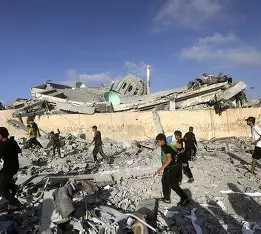By Innovation Times News Correspondent
Tensions in Gaza reached new heights on Friday as Hamas launched a violent assault against the al-Mujaida clan, one of the largest and most influential families in southern Gaza. According to Hamas statements, social media footage, and multiple Palestinian media reports, the militant group claimed it was targeting individuals allegedly collaborating with Israel. What began as an operation to “carry out arrests” quickly spiraled into an armed confrontation that left several dead and others brutally mistreated.
Witnesses and local sources said that at least 11 Hamas fighters were killed during the exchange of fire. In scenes that have shocked residents and observers alike, their bodies were reportedly dragged through the streets by angry members of the al-Mujaida clan. BBC News and other outlets cited disturbing video footage showing the aftermath of the gun battle, which erupted near the clan’s stronghold in southern Gaza. The fighting also claimed the lives of at least five members of the al-Mujaida family, further inflaming long-standing tensions between local clans and Hamas’ governing forces.
Reports from Palestinian news outlets and social media platforms suggest that Hamas forces stormed civilian homes using improvised explosive devices (IEDs) and rocket-propelled grenades (RPGs), even as many residents were performing morning prayers. Eyewitnesses described the chaos as explosions echoed across residential neighborhoods, leaving families trapped indoors and sparking panic among civilians. Entire streets were reportedly reduced to rubble as the gunfire raged through the morning.
Analysts familiar with Gaza’s internal power structure say the attack on the al-Mujaida clan represents a dangerous escalation in Hamas’ attempts to assert control over local power centers. The al-Mujaida family, like several other powerful clans in Gaza, has long operated with relative autonomy and maintains its own armed members. The recent confrontation therefore reflects not just political tension but also the erosion of internal stability within the enclave, already battered by ongoing conflict with Israel.
The public display of the Hamas fighters’ bodies marks a significant symbolic blow to the group’s authority. Such scenes are rare in Gaza, where Hamas has maintained tight control through fear and surveillance. The images, widely shared online, have fueled outrage and debate across Palestinian society, with some viewing the incident as a sign that the group’s grip on Gaza may be weakening under pressure from both external and internal enemies.
Human rights observers warn that the clash underscores the growing lawlessness in Gaza, where clan rivalries, militant operations, and humanitarian breakdowns now intersect. The collapse of civil order and the use of heavy weaponry in residential areas have heightened fears that civilians are increasingly caught between warring factions. Aid agencies have already raised concerns that internal fighting could further obstruct humanitarian access to southern Gaza, where tens of thousands of displaced residents remain in urgent need of food, water, and medical care.
Political analysts also suggest that the incident could have broader implications for ongoing ceasefire and hostage negotiations. The emergence of clan-based militias challenging Hamas’ dominance complicates Israel’s efforts to identify clear negotiating partners and raises questions about who truly controls various zones in Gaza. Some experts warn that without a unified leadership structure, efforts to broker long-term stability could collapse into localized civil strife.
Despite the group’s public statements claiming the operation was aimed at rooting out collaborators, the scale and brutality of the attack have backfired politically, exposing Hamas to accusations of abusing power and terrorizing its own population. For many in Gaza, the images of dead Hamas fighters paraded through the streets mark a turning point, a moment when fear began to give way to defiance.
As of Friday evening, the situation in southern Gaza remained tense, with reports of sporadic gunfire and heavy security presence. Both Hamas and the al-Mujaida clan have yet to release full casualty lists, and independent verification remains difficult due to restricted media access in the region.
International observers have called for an immediate de-escalation and urged humanitarian corridors to remain open to prevent further civilian suffering. However, with anger running high and the political vacuum deepening, many fear that Gaza may be entering one of its most unstable periods in years.



